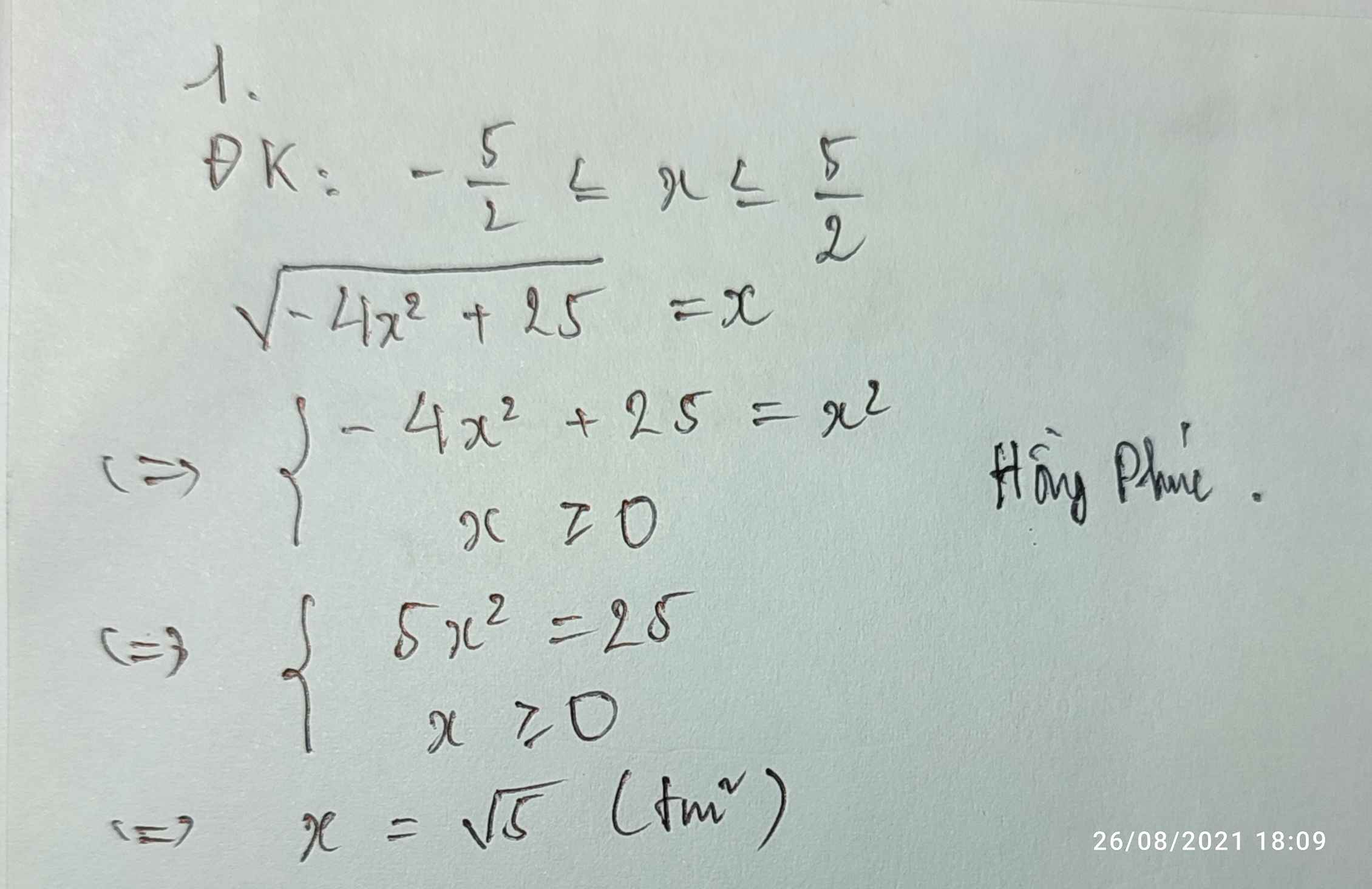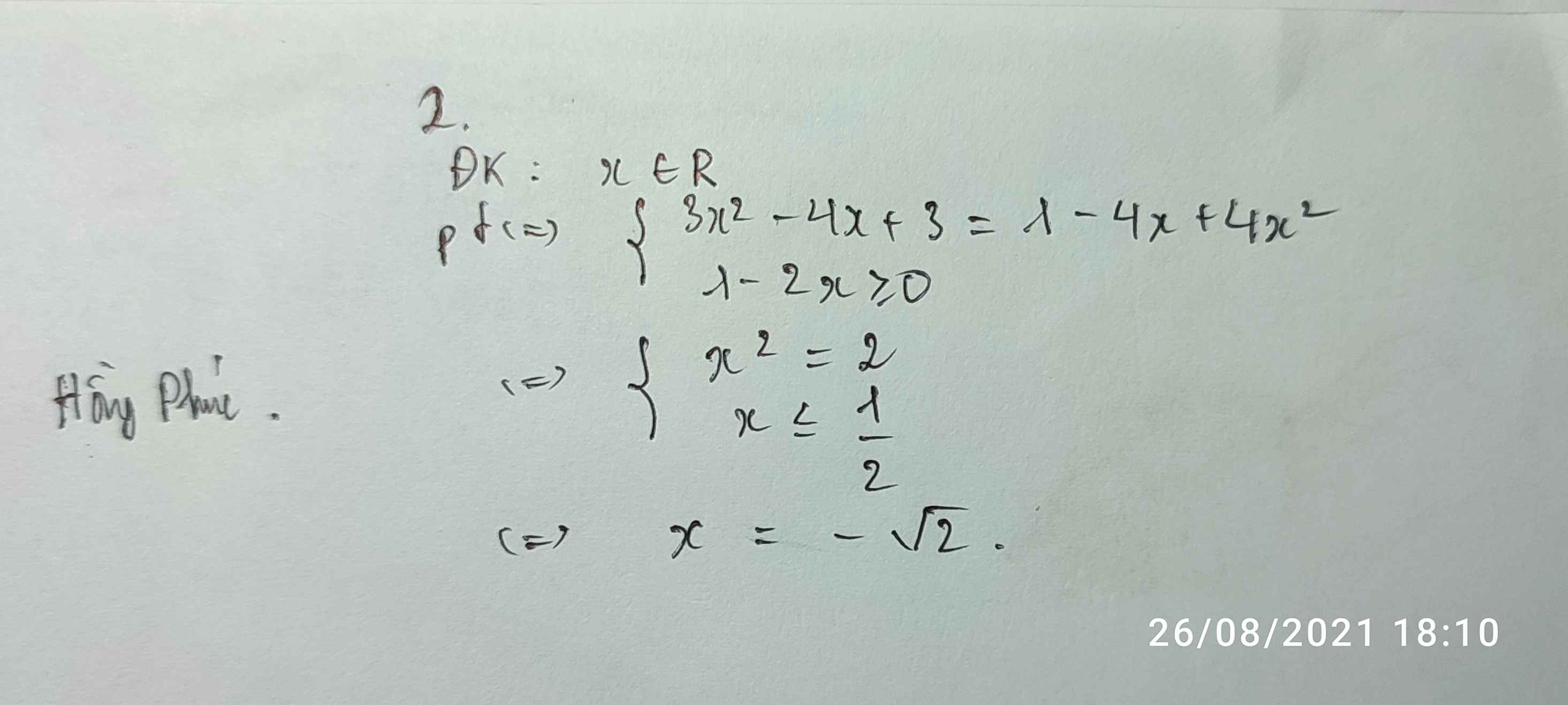1) sqrt(2x - 5) - sqrt(x + 1) = 0 2) sqrt(x ^ 2 - 4x + 4) = 3x + 1

Những câu hỏi liên quan
1.\(\sqrt{-4x^2+25}=x\)
2.\(\sqrt{3x^2-4x+3}=1-2x\)
3. \(\sqrt{4\left(1-x\right)^2}-\sqrt{3}=0\)
4.\(\dfrac{3\sqrt{x+5}}{\sqrt{ }x-1}< 0\)
5. \(\dfrac{3\sqrt{x-5}}{\sqrt{x+1}}\ge0\)
Giải phương trình:
1. \(5x^2+2x+10=7\sqrt{x^4+4}\)
2. \(\dfrac{4}{x}+\sqrt{x-\dfrac{1}{x}}=x+\sqrt{2x-\dfrac{5}{x}}\)
3. \(\sqrt{x^2+2x}=\sqrt{3x^2+4x+1}-\sqrt{3x^2+4x+1}\)
Giải phương trình:
1, sqrt{x^2+2x}+sqrt{2x-1}sqrt{3x^2+4x+1}
2, x^3-3x^2+2sqrt{left(x+2right)^3}-6x0
3, 2x^3-x^2-3x+1sqrt{x^5+x^4+1}
4, 5sqrt{x^4+8x}4x^2+8
5, left(x^2+4right)sqrt{2x+4}3x^2+6x-4
6, left(x^2-6x+11right)sqrt{x^2-x+1}2left(x^2-4x+7right)sqrt{x-2}
Đọc tiếp
Giải phương trình:
1, \(\sqrt{x^2+2x}+\sqrt{2x-1}=\sqrt{3x^2+4x+1}\)
2, \(x^3-3x^2+2\sqrt{\left(x+2\right)^3}-6x=0\)
3, \(2x^3-x^2-3x+1=\sqrt{x^5+x^4+1}\)
4, \(5\sqrt{x^4+8x}=4x^2+8\)
5, \(\left(x^2+4\right)\sqrt{2x+4}=3x^2+6x-4\)
6, \(\left(x^2-6x+11\right)\sqrt{x^2-x+1}=2\left(x^2-4x+7\right)\sqrt{x-2}\)
giải pt
1) \(\sqrt{x+3}+\sqrt{3x+1}+4\sqrt{5-x}=12\)
2) \(x+4\sqrt{x+3}+2\sqrt{3-2x}=11\)
3) \(4x\sqrt{x+3}+2\sqrt{2x-1}=4x^2+3x+3\)
4) \(x^4-x^2+3x+5-2\sqrt{x+2}=0\)
ai giải hộ với nhanh cái mk sắp đi học òi
Đúng 0
Bình luận (0)
1) \(\left|x^2-4x-5\right|=x-1\)
2) \(\sqrt{2x^2+2x+9}=x-3\)
3) \(\sqrt{x+1}+1=4x^2+\sqrt{3x}\)
4) \(\sqrt{x-2}+\sqrt{4-x}=2x^2-5x-3\)
1) Ta có: \(\left|x^2-4x-5\right|=x-1\)
\(\Leftrightarrow\left[{}\begin{matrix}x^2-4x-5=x-1\left(\left[{}\begin{matrix}x>5\\x< -1\end{matrix}\right.\right)\\-x^2+4x+5=x-1\left(-1< x< 5\right)\end{matrix}\right.\)
\(\Leftrightarrow\left[{}\begin{matrix}x^2-4x-5-x+1=0\\-x^2+4x+5-x+1=0\end{matrix}\right.\)
\(\Leftrightarrow\left[{}\begin{matrix}x^2-5x-4=0\\-x^2+3x+6=0\end{matrix}\right.\Leftrightarrow x^2-2\cdot x\cdot\dfrac{5}{2}+\dfrac{25}{4}-\dfrac{41}{4}=0\)
\(\Leftrightarrow\left(x-\dfrac{5}{2}\right)^2=\dfrac{41}{4}\)
\(\Leftrightarrow\left[{}\begin{matrix}x-\dfrac{5}{2}=\dfrac{\sqrt{41}}{2}\\x-\dfrac{5}{2}=-\dfrac{\sqrt{41}}{2}\end{matrix}\right.\Leftrightarrow\left[{}\begin{matrix}x=\dfrac{\sqrt{41}+5}{2}\left(nhận\right)\\x=\dfrac{-\sqrt{41}+5}{2}\left(loại\right)\end{matrix}\right.\)
Vậy: \(S=\left\{\dfrac{\sqrt{41}+5}{2}\right\}\)
Đúng 0
Bình luận (0)
Giải phương trình:
a) sqrt{x+2}sqrt{2x+1}+xsqrt{x+2}
b) 2+sqrt{3-8x}6x+sqrt{4x-1}
c) sqrt{10x+1}+sqrt{3x-5}sqrt{9x+4}+sqrt{2x-1}
d) 1+sqrt{x^2+4x}sqrt{x^2-3x+3}+sqrt{2x^2+x+2}
e) sqrt{x^2+15}3x-2+sqrt{x^2+8}
f) left(sqrt{x+5}-sqrt{x+2}right)left(1+sqrt{x^2+7x+10}right)3
g) sqrt{3x^2-7x+3}-sqrt{x^2-2}sqrt{3x^2-5x-1}-sqrt{x^2-3x+4}
h) sqrt{2x^2+x-1}+sqrt{3x^2+x-1}sqrt{x^2+4x-3}+sqrt{2x^2+4x-3}
Đọc tiếp
Giải phương trình:
a) \(\sqrt{x+2}=\sqrt{2x+1}+x\sqrt{x+2}\)
b) \(2+\sqrt{3-8x}=6x+\sqrt{4x-1}\)
c) \(\sqrt{10x+1}+\sqrt{3x-5}=\sqrt{9x+4}+\sqrt{2x-1}\)
d) \(1+\sqrt{x^2+4x}=\sqrt{x^2-3x+3}+\sqrt{2x^2+x+2}\)
e) \(\sqrt{x^2+15}=3x-2+\sqrt{x^2+8}\)
f) \(\left(\sqrt{x+5}-\sqrt{x+2}\right)\left(1+\sqrt{x^2+7x+10}\right)=3\)
g) \(\sqrt{3x^2-7x+3}-\sqrt{x^2-2}=\sqrt{3x^2-5x-1}-\sqrt{x^2-3x+4}\)
h) \(\sqrt{2x^2+x-1}+\sqrt{3x^2+x-1}=\sqrt{x^2+4x-3}+\sqrt{2x^2+4x-3}\)
đa phần mình sử dụng phương pháp liên hợp nha bạn
\(\sqrt{a}-\sqrt{b}=\dfrac{a-b}{\sqrt{a}+\sqrt{b}}\)
b. điều kiện \(\dfrac{1}{4}\le x\le\dfrac{3}{8}\), pt:
\(\Leftrightarrow\sqrt{3-8x}-\sqrt{4x-1}=6x-2\\ \Leftrightarrow\dfrac{3-8x-4x+1}{\sqrt{3-8x}+\sqrt{4x-1}}=2\left(3x-1\right)\\ \Leftrightarrow\dfrac{-4\left(3x-1\right)}{\sqrt{3-8x}+\sqrt{4x-1}}=2\left(3x-1\right)\\ \Leftrightarrow2\left(3x-1\right)+\dfrac{4\left(3x-1\right)}{\sqrt{3-8x}+\sqrt{4x-1}}=0\\ \Leftrightarrow2\left(3x-1\right)\left(1+\dfrac{2}{\sqrt{3-8x}+\sqrt{4x-1}}\right)=0\)
\(\Leftrightarrow\left[{}\begin{matrix}x=\dfrac{1}{3}\left(n\right)\\1+\dfrac{2}{\sqrt{3-8x}+\sqrt{4x-1}}=0\left(vn\right)\end{matrix}\right.\)
d. điều kiện: \(x\le-4\cup x\ge0\), pt:
\(\Leftrightarrow1-\sqrt{x^2-3x+3}=\sqrt{2x^2+x+2}-\sqrt{x^2+4x}\\ \Leftrightarrow\dfrac{1-x^2+3x-3}{1+\sqrt{x^2-3x+3}}=\dfrac{2x^2+x+2-x^2-4x}{\sqrt{2x^2+x+2}+\sqrt{x^2+4x}}\\ \Leftrightarrow\dfrac{-\left(x-1\right)\left(x-2\right)}{1+\sqrt{x^2-3x+3}}=\dfrac{\left(x-1\right)\left(x-2\right)}{\sqrt{2x^2+x+2}+\sqrt{x^2+4x}}\)
\(\Leftrightarrow\left[{}\begin{matrix}x=2\left(n\right)\\x=1\left(n\right)\\\dfrac{-1}{1+\sqrt{x^2-3x+3}}=\dfrac{1}{\sqrt{2x^2+x+2}+\sqrt{x^2+4x}}\left(vn\right)\end{matrix}\right.\)
e. điều kiện:x thuộc R
\(\Leftrightarrow\sqrt{x^2+15}-4=3x-3+\sqrt{x^2+8}-3\\ \Leftrightarrow\dfrac{x^2+15-16}{\sqrt{x^2+15}+4}=3\left(x-1\right)+\dfrac{x^2+8-9}{\sqrt{x^2+8}+3}\\ \Leftrightarrow\dfrac{\left(x-1\right)\left(x+1\right)}{\sqrt{x^2+15}+4}-3\left(x-1\right)-\dfrac{\left(x-1\right)\left(x+1\right)}{\sqrt{x^2+8}+3}=0\)
\(\Leftrightarrow\left[{}\begin{matrix}x=1\\\dfrac{\left(x+1\right)}{\sqrt{x^2+15}+4}-3-\dfrac{\left(x+1\right)}{\sqrt{x^2+8}+3}=0\left(1\right)\end{matrix}\right.\)
(1) mình không biết có vô nghiệm không nữa và cũng thua luôn
f. điều kiện: \(x\ge-2\)
bài này giải cách hơi khác một chút
đặt \(a=\sqrt{x+5}\left(\ge0\right)\\ b=\sqrt{x+2}\left(\ge0\right)\)
pt:
\(\Leftrightarrow\left(\sqrt{x+5}-\sqrt{x+2}\right)\left[\left(1+\sqrt{\left(x+5\right)\left(x+2\right)}\right)\right]\\ \Rightarrow\left(a-b\right)\left(1+ab\right)=3\left(1\right)\)
mà \(a^2-b^2=x+5-x-2=3\\ \Rightarrow\left(a-b\right)\left(a+b\right)=3\left(2\right)\)
=> (1) = (2)
\(\Leftrightarrow\left(a-b\right)\left(1+ab\right)=\left(a-b\right)\left(a+b\right)\\ \Leftrightarrow\left(a-b\right)\left(1+ab-a-b\right)=0\\ \Leftrightarrow\left(a-b\right)\left(a-1\right)\left(b-1\right)=0\)
TH1: a=b \(\Leftrightarrow\sqrt{x+5}=\sqrt{x+2}\Leftrightarrow x+5=x+2\left(vn\right)\)
TH2: a=1\(\Leftrightarrow\sqrt{x+5}=1\Leftrightarrow x=-4\left(l\right)\)
TH3: b=1\(\Leftrightarrow\sqrt{x+2}=1\Leftrightarrow x=-1\left(n\right)\)
g. điều kiện: \(x\le-\sqrt{2}\cup x\ge\dfrac{7+\sqrt{37}}{2}\)
pt:
\(\dfrac{3x^2-7x+3-3x^2+5x+1}{\sqrt{3x^2-7x+2}+\sqrt{x^2-3x-4}}=\dfrac{x^2-2-x^2+3x-4}{\sqrt{3x^2-5x-1}+\sqrt{x^2-2}}\\ \Leftrightarrow\dfrac{-2\left(x-2\right)}{\sqrt{3x^2-7x+2}+\sqrt{x^2-3x-4}}=\dfrac{3\left(x-2\right)}{\sqrt{3x^2-5x-1}+\sqrt{x^2-2}}\)
\(\Leftrightarrow\left[{}\begin{matrix}x=-2\left(n\right)\\\dfrac{-2}{\sqrt{3x^2-7x+2}+\sqrt{x^2-3x-4}}=\dfrac{3}{\sqrt{3x^2-5x-1}+\sqrt{x^2-2}}\left(vn\right)\end{matrix}\right.\)h. điều kiện \(x\le-2-\sqrt{7}\cup x\ge-2+\sqrt{7}\)
\(\sqrt{2x^2+x-1}-\sqrt{x^2+4x-3}=\sqrt{2x^2+4x-3}-\sqrt{3x^2+x-1}\\ \Leftrightarrow\dfrac{2x^2+x-1-x^2-4x+3}{\sqrt{2x^2+x-1}+\sqrt{x^2+4x-3}}=\dfrac{2x^2+4x-3-3x^2-x+1}{\sqrt{2x^2+4x-3}+\sqrt{3x^2+x-1}}\\ \Leftrightarrow\dfrac{x^2-3x+2}{\sqrt{2x^2+x-1}+\sqrt{x^2+4x-3}}=\dfrac{-\left(x^2-3x+2\right)}{\sqrt{2x^2+4x-3}+\sqrt{3x^2+x-1}}\)
\(\Leftrightarrow\left[{}\begin{matrix}x^2-3x+2=0\Leftrightarrow x=1\left(n\right),x=2\left(n\right)\\\dfrac{1}{\sqrt{2x^2+x-1}+\sqrt{x^2+4x-3}}=\dfrac{-1}{\sqrt{2x^2+4x-3}+\sqrt{3x^2+x-1}}\left(vn\right)\end{matrix}\right.\)
(nhớ tích cho mình nha, mấy bài kia mình ko biết làm huhu)
Đúng 0
Bình luận (1)
Giải các phương trình sau
\(1)\sqrt{x}+\sqrt{x^2-1}=\sqrt{2x^2-3x-4}\)
\(2)x^3+\left(3x^2-4x-4\right)\sqrt{x+1}=0\)
1.
ĐKXĐ: \(x\ge\dfrac{3+\sqrt{41}}{4}\)
\(\Leftrightarrow x^2+x-1+2\sqrt{x\left(x^2-1\right)}=2x^2-3x-4\)
\(\Leftrightarrow x^2-4x-3-2\sqrt{\left(x^2-x\right)\left(x+1\right)}=0\)
Đặt \(\left\{{}\begin{matrix}\sqrt{x^2-x}=a>0\\\sqrt{x+1}=b>0\end{matrix}\right.\)
\(\Rightarrow a^2-3b^2-2ab=0\)
\(\Leftrightarrow\left(a+b\right)\left(a-3b\right)=0\)
\(\Leftrightarrow a=3b\)
\(\Leftrightarrow\sqrt{x^2-x}=3\sqrt{x+1}\)
\(\Leftrightarrow x^2-x=9\left(x+1\right)\)
\(\Leftrightarrow...\) (bạn tự hoàn thành nhé)
Đúng 0
Bình luận (0)
2.
ĐKXĐ: \(x\ge-1\)
Đặt \(\sqrt{x+1}=a\ge0\) pt trở thành:
\(x^3+3\left(x^2-4a^2\right)a=0\)
\(\Leftrightarrow x^3+3ax^2-4a^3=0\)
\(\Leftrightarrow\left(x-a\right)\left(x+2a\right)^2=0\)
\(\Leftrightarrow\left[{}\begin{matrix}a=x\\2a=-x\end{matrix}\right.\)
\(\Leftrightarrow\left[{}\begin{matrix}\sqrt{x+1}=x\left(x\ge0\right)\\2\sqrt{x+1}=-x\left(x\le0\right)\end{matrix}\right.\)
\(\Leftrightarrow\left[{}\begin{matrix}x^2=x+1\\x^2=4x+4\end{matrix}\right.\)
\(\Leftrightarrow\left[{}\begin{matrix}x^2-x-1=0\\x^2-4x-4=0\end{matrix}\right.\)
\(\Leftrightarrow\left[{}\begin{matrix}x=\dfrac{1+\sqrt{5}}{2}\\x=2-2\sqrt{2}\end{matrix}\right.\)
Đúng 0
Bình luận (0)
Bài 2. Giải các phương trình sau. a) 3x - 2sqrt(x - 1) = 4 b) sqrt(4x + 1) - sqrt(x + 2) = sqrt(3 - x) c) (sqrt(x - 1) - sqrt(5 - x))(|10 - x| + 2x - 16) = 0
a) \(3x-2\sqrt{x-1}=4\) (ĐK: x ≥ 1)
\(\Rightarrow3x-2\sqrt{x-1}-4=0\)
\(\Rightarrow3x-6-2\sqrt{x-1}+2=0\)
\(\Rightarrow3\left(x-2\right)-2\left(\sqrt{x-1}-1\right)=0\)
\(\Rightarrow3\left(x-2\right)-2.\dfrac{x-2}{\sqrt{x-1}+1}=0\)
\(\Rightarrow\left(x-2\right)\left[3-\dfrac{2}{\sqrt{x-1}+1}\right]=0\)
*TH1: x = 2 (t/m)
*TH2: \(3-\dfrac{2}{\sqrt{x-1}+1}=0\)
\(\Rightarrow3=\dfrac{2}{\sqrt{x-1}+1}\)
\(\Rightarrow3\sqrt{x-1}+3=2\)
\(\Rightarrow3\sqrt{x-1}=-1\) (vô lí)
Vậy S = {2}
b) \(\sqrt{4x+1}-\sqrt{x+2}=\sqrt{3-x}\) (ĐK: \(-\dfrac{1}{4}\le x\le3\) )
\(\Rightarrow\sqrt{4x+1}-3-\sqrt{x+2}+2-\sqrt{3-x}+1=0\)
\(\Rightarrow\dfrac{4x-8}{\sqrt{4x+1}+3}-\dfrac{x-2}{\sqrt{x+2}+2}+\dfrac{x-2}{\sqrt{3-x}+1}=0\)
\(\Rightarrow\left(x-2\right)\left(\dfrac{4}{\sqrt{4x+1}+3}-\dfrac{1}{\sqrt{x+2}+2}+\dfrac{1}{\sqrt{3-x}+1}\right)=0\)
=> x = 2
Đúng 0
Bình luận (0)
\(a,3x-2\sqrt{x-1}=4\left(x\ge1\right)\\ \Leftrightarrow-2\sqrt{x-1}=4-3x\\ \Leftrightarrow4\left(x-1\right)=16-24x+9x^2\\ \Leftrightarrow9x^2-28x+20=0\\ \Leftrightarrow\left(x-2\right)\left(9x-10\right)=0\\ \Leftrightarrow\left[{}\begin{matrix}x=2\left(tm\right)\\x=\dfrac{10}{9}\left(tm\right)\end{matrix}\right.\)
\(b,\sqrt{4x+1}-\sqrt{x+2}=\sqrt{3-x}\left(-\dfrac{1}{4}\le x\le3\right)\\ \Leftrightarrow4x+1+x+2-2\sqrt{\left(4x+1\right)\left(x+2\right)}=3-x\\ \Leftrightarrow-2\sqrt{\left(4x+1\right)\left(x+2\right)}=2-6x\\ \Leftrightarrow\sqrt{4x^2+9x+2}=3x-1\\ \Leftrightarrow4x^2+9x+2=9x^2-6x+1\\ \Leftrightarrow5x^2-15x-1=0\\ \Leftrightarrow\Delta=225+20=245\\ \Leftrightarrow\left[{}\begin{matrix}x=\dfrac{15-\sqrt{245}}{10}=\dfrac{15-7\sqrt{5}}{10}\left(ktm\right)\\x=\dfrac{15+\sqrt{245}}{10}=\dfrac{15+7\sqrt{5}}{10}\left(tm\right)\end{matrix}\right.\Leftrightarrow x=\dfrac{15+7\sqrt{5}}{10}\)
Đúng 1
Bình luận (0)
Giải pt
\(1)4x^2+\sqrt{3x+1}+5=13x\)
\(2)7x^2-13x+8=2x^2.\sqrt[3]{x\left(1+3x-3x^2\right)}\)
\(3)x^3-4x^2-5x+6=\sqrt[3]{7x^2+9x-4}\)
\(4)x^3-5x^2+4x-5=\left(1-2x\right)\sqrt[3]{6x^2-2x+7}\)
\(5)8x^2-13x+7=\left(1+\dfrac{1}{x}\right)\sqrt[3]{3x^2-2}\)
Để giải các phương trình này, chúng ta sẽ làm từng bước như sau: 1. 13x(7-x) = 26: Mở ngoặc và rút gọn: 91x - 13x^2 = 26 Chuyển về dạng bậc hai: 13x^2 - 91x + 26 = 0 Giải phương trình bậc hai này để tìm giá trị của x. 2. (4x-18)/3 = 2: Nhân cả hai vế của phương trình với 3 để loại bỏ mẫu số: 4x - 18 = 6 Cộng thêm 18 vào cả hai vế: 4x = 24 Chia cả hai vế cho 4: x = 6 3. 2xx + 98x2022 = 98x2023: Rút gọn các thành phần: 2x^2 + 98x^2022 = 98x^2023 Chia cả hai vế cho 2x^2022: x + 49 = 49x Chuyển các thành phần chứa x về cùng một vế: 49x - x = 49 Rút gọn: 48x = 49 Chia cả hai vế cho 48: x = 49/48 4. (x+1) + (x+3) + (x+5) + ... + (x+101): Đây là một dãy số hình học có công sai d = 2 (do mỗi số tiếp theo cách nhau 2 đơn vị). Số phần tử trong dãy là n = 101/2 + 1 = 51. Áp dụng công thức tổng của dãy số hình học: S = (n/2)(a + l), trong đó a là số đầu tiên, l là số cuối cùng. S = (51/2)(x + (x + 2(51-1))) = (51/2)(x + (x + 100)) = (51/2)(2x + 100) = 51(x + 50) Vậy, kết quả của các phương trình là: 1. x = giá trị tìm được từ phương trình bậc hai. 2. x = 6 3. x = 49/48 4. S = 51(x + 50)
Đúng 0
Bình luận (0)





















